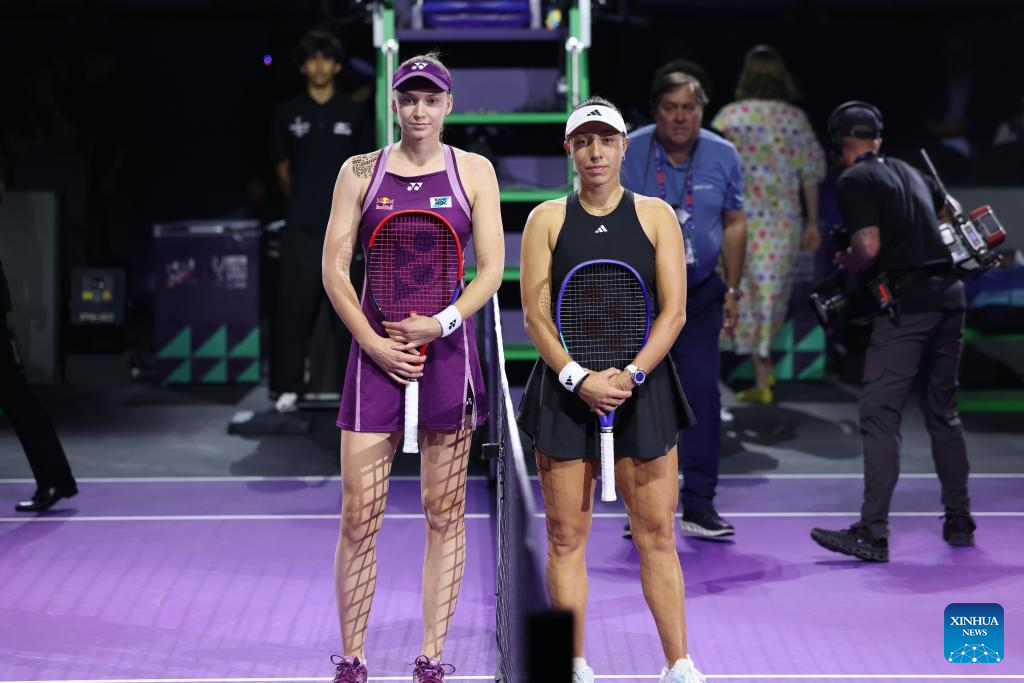Elena Rybakina (L) and Jessica Pegula pose for photos before the semifinal between Elena Rybakina of Kazakhstan and Jessica Pegula of the United States at WTA Finals tennis tournament in Riyadh, Saudi Arabia, Nov. 7, 2025. (Xinhua/Wang Haizhou)


Elena Rybakina (L) and Jessica Pegula pose for photos before the semifinal between Elena Rybakina of Kazakhstan and Jessica Pegula of the United States at WTA Finals tennis tournament in Riyadh, Saudi Arabia, Nov. 7, 2025. (Xinhua/Wang Haizhou)


Reaching for CBD-infused lotion or oil may seem like a low-risk way to find pain relief, but little is actually known about the impact that CBD has on the nervous system.
Over the past decade, the use of cannabis products for pain…

KARACHI: The Pakistan Idol theatre round has entered an even more…

Nikita YadavBBC News, Delhi
 Future Publishing via Getty Images
Future Publishing via Getty ImagesStarting this week, millions of Indians will get one year of free access to ChatGPT’s new, low-cost “Go” AI chatbot.
The move follows similar announcements in recent weeks from Google and Perplexity AI, who have partnered with local Indian mobile companies to give users a year or more of free access to their AI tools.
Perplexity tied up with the country’s second largest mobile network provider Airtel, while Google partnered with Reliance Jio, India’s largest telephony giant, to bundle free or discounted AI tools with monthly data packs.
Analysts say such offers shouldn’t be mistaken for generosity as they are calculated investments and a long-term bet on India’s digital future.
“The plan is to get Indians hooked on to generative AI before asking them to pay for it,” Tarun Pathak, an analyst at Counterpoint Research, told the BBC.
“What India offers is scale and a young audience,” says Mr Pathak, adding that other big markets like China might rival India in terms of the number of users, but its tightly regulated tech environment limits foreign access.
India, by contrast, offers an open and competitive digital market and global tech is clinching the opportunity to enlist millions of new users here to train their AI models.
OpenAI, Perplexity and Google did not respond to the BBC’s queries.
India has over 900 million internet users and offers some of the world’s cheapest data. Its online population is young – most internet users are under the age of 24, belonging to a generation that lives, works and socialises online, using smartphones.
Bundling these AI tools with data packs creates a massive opportunity for tech companies given India’s data consumption outpaces much of the world. The more Indians use these platforms, the more first-hand data companies can access.
“India is an incredibly diverse country. The AI use cases emerging from here will serve as valuable case studies for the rest of the world,” says Mr Pathak.
“The more unique, first-hand data they gather, the better their models, particularly generative AI systems, become.”
While a win-win for AI companies, these free offerings raise questions from a consumer perspective, especially regarding implications on data privacy.
“Most users have always been willing to give up data for convenience or something free and that will continue,” says Delhi-based technology writer and analyst Prasanto K Roy.
But this is where the government will have to step in, he says.
“Regulation will need to increase as authorities figure out how to manage the broader issue of people giving away their data so freely,” says Mr Roy.
 NurPhoto via Getty Images
NurPhoto via Getty ImagesAt present, India does not have a dedicated law governing artificial intelligence. There is the broader Digital Personal Data Protection Act (DPDP) 2023 around digital media and privacy, but it is yet to be enacted.
Experts say that while the act introduces broad protections around personal data, its implementation rules are still pending and it does not yet address AI systems or algorithmic accountability.
But once the law comes into effect “it will probably be one of the most advanced from a digital [privacy] perspective”, Mahesh Makhija, technology consulting leader at Ernst and Young told the BBC.
For now though, India’s flexible regulatory environment allows companies like OpenAI and Google to bundle free AI tools with telecom plans, something far harder to do in other countries.
For instance, the European Union’s AI rules set tough standards for transparency and data governance, while South Korea’s incoming regulations go a step further, requiring labels on AI-generated content and making operators answerable for how their systems are used.
In these regions, such offers would have triggered compliance requirements around user consent and data protection, making them harder to roll out at scale.
Mr Roy says India needs both stronger user awareness and clearer regulation, but without stifling innovation.
“At this point, we need light-touch regulation, but that will have to evolve as the extent of potential harm becomes clearer”.
Until then, the global AI companies will be hoping that by offering these freebies they can replicate India’s past experience of onboarding millions of new users with deeply discounted internet data.
While AI is unlikely to follow a heavily monetised model and is instead expected to be adopted as a low-cost, value-driven service, the country’s sheer volumes offer promise.
“For instance, even if just 5% of free users become subscribers, that’s still a significant number,” says Mr Pathak.
Follow BBC News India on Instagram, YouTube, X and Facebook.